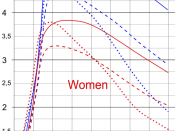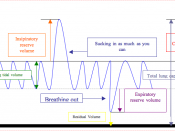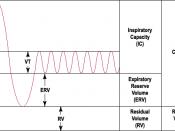Introduction:Spirometry is the classic pulmonary function test, which measures the volume of air inspired or expired as a function of time. It can monitor quiet breathing and thereby measure tidal volume, and also trace deep inspirations and expirations to give information about vital capacity. Spirometrymay also be used to measure forced expiration rates and volumes and to compute FEV1/FVC ratios. Spirometry provides an objective measurement of lung function. It will measure the Expiratory Vital Capacity (EVC): The maximum volume of gas which can be expired from the lungs during a relaxed expiration from a position of full inspiration. It will also measure the Inspiratory Vital Capacity (IVC): The maximum volume of gas which can be inspired into the lungs during a relaxed inspiration from a position of full expiration. The expiratory phase is the one more commonly used to measure obstruction and restriction within the lungs. This can be done in two ways: first by a Static test - performed without regard to time e.g.
Vital Capacity (VC) and also by a Dynamic test - performed at forcible and maximum effort against time. e.g. FEV, (Forced expiratory volume in the first second from a maximum inspiration) (ALA, 1).
The Schneider test for physical fitness is a test devised to measure pulse rates before and after exercise. The importance of good exercise helps the cardiovascular system work on sudden changes on demand if an individual exhibits good exercise skills that help the pulse rate increase and decrease when the body needs it (AHA, 1.) The purpose for this experiment is to give the student the opportunity to measure the lung capacity of a student and to measure the pulse rate of this student.
Results: Spirometry TestSubject12Tidal Volume1366600Minute Reserve Volume54648400Expiratory Reserve Volume17001300Vital Capacity46334400Inspiratory Capacity29333100Inspiratory Reserve Volume15672500Results:Schneider Physical Fitness TestPulse RateScoreReclining Pulse703Standing Pulse Rate803Pulse Rate on Standing83Return of Pulse to Standing Normal762Pulse Rate Increase after Exercise43Total 14Discussion:In the results for Subject 1 and Subject 2 displayed in their spirometry normal results FEV. For example: The results of spirometry tests are compared to predicted values based on the patient's age, gender, and height. For example, a young adult in good health is expected to have the following FEV values:â¢FEV-0.5-50-60% of FVCâ¢FEV-1-75-85% of FVCâ¢FEV-2-95% of FVCâ¢FEV-3-97% of FVCIn general, a normal result is 80-100% of the predicted value. Abnormal values are:â¢mild lung dysfunction-60-79%â¢moderate lung dysfunction-40-59%â¢Severe lung dysfunction-below 40% (SSO, 2).
In the Schneider's Physical Test, the subject final test score number was 14, whichMeans according to the guidelines of the test that if the final score falls between 16-14,This means the person is in good physical health.
Conclusion:The results of all subjects illustrated to the lab students that participated in this experiment that they were in good heath. According to the guidelines for the results of both tests, the subjects fair normal, are healthy, and average for their possible age. The importance for perhaps in learning how to follow these techniques might be in keeping track of one's own physical state along with learning the techniques of a physiology class (SS0, 1).
Works CitedAmerican Heart Association. Pulse Rate and Blood Pressure. Http://www.americanheart.
Org/presenter.jhtml?identifier=1200000. (April 1, 2006).
American Lung Association. Spirometry and Other Lung Functions. Http://www.lungusa.
org/site/pp.asp?c=dvLUK9O0E&b=43918. (April 1, 2006).
Social Security Online. The Respiratory System: Interpreting Results. Http://www.ssagov/disability/professionals/bluebook/3.00-Respiratory-Adult.htm. (April 1,2006).


